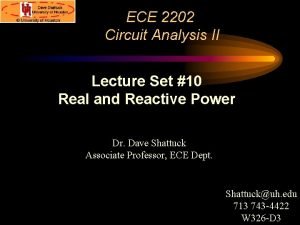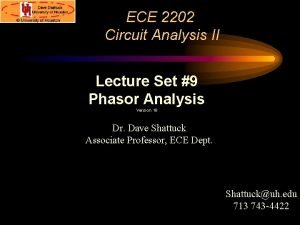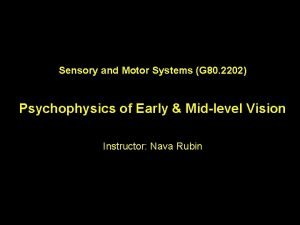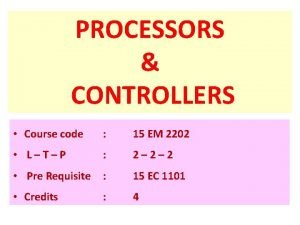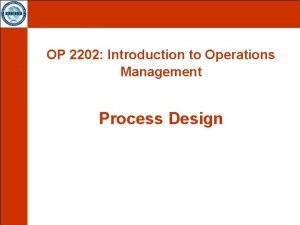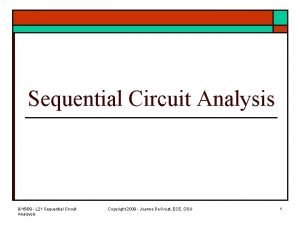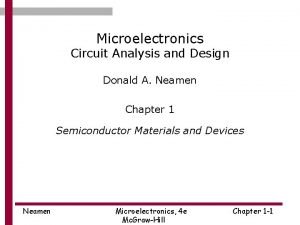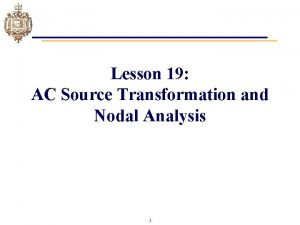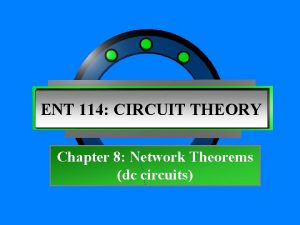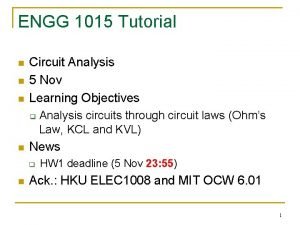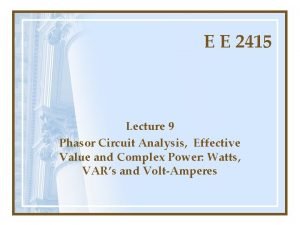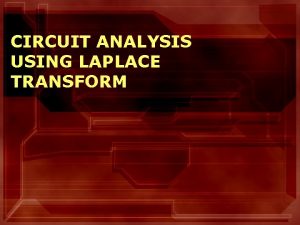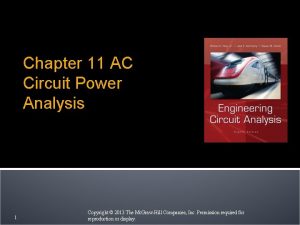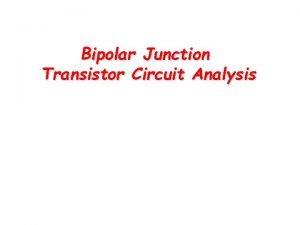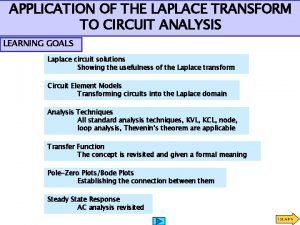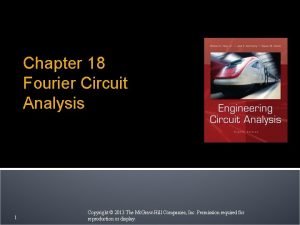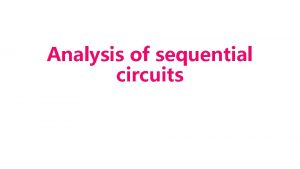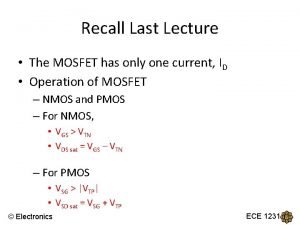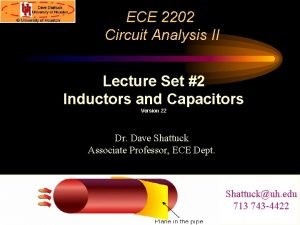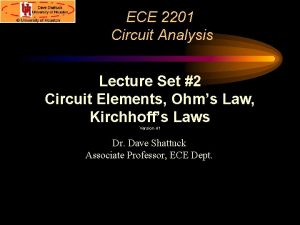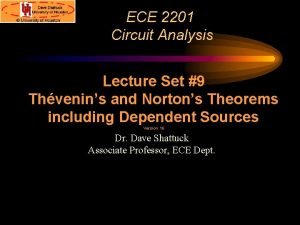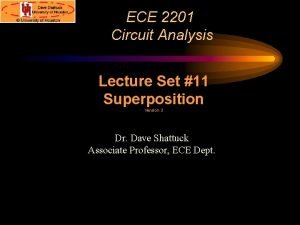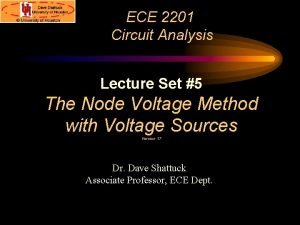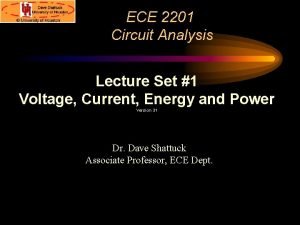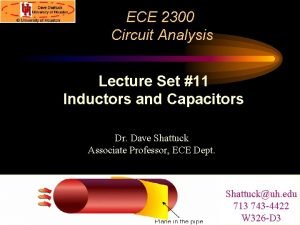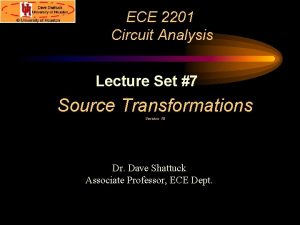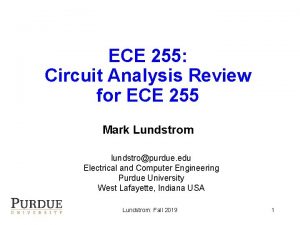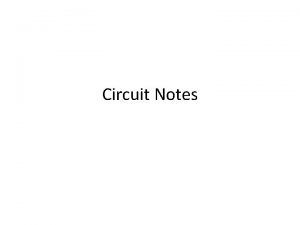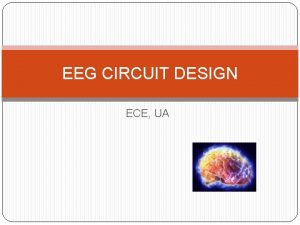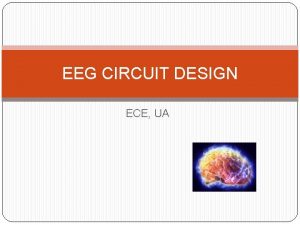ECE 2202 Circuit Analysis II Lecture Set 4




















![Note 5 – RL 9. 2[m. A] Here is an example plot with i. Note 5 – RL 9. 2[m. A] Here is an example plot with i.](https://slidetodoc.com/presentation_image_h2/f65e083c9a8d7de452e4e24fcca867b5/image-21.jpg)

























- Slides: 46

ECE 2202 Circuit Analysis II Lecture Set #4 Step Response Version 17 Dr. Dave Shattuck Associate Professor, ECE Dept. Shattuck@uh. edu 713 743 -4422

Lecture Set #4 Step Response of First Order Circuits

Overview of this Lecture Step Response of First Order Circuits In this lecture, we will cover the following topics: • Step Response for RL circuits • Step Response for RC circuits • Generalized Solution for Step Response Circuits

Textbook Coverage Approximately this same material is covered in your textbook in the following sections: • Electric Circuits 7 th Edition by Nilsson and Riedel: Sections 7. 3 and 7. 4 • Electric Circuits 10 th Edition by Nilsson and Riedel: Sections 7. 3 and 7. 4

6 Different First-Order Circuits There are six different STC circuits. These are listed below. • An inductor and a resistance (called RL Natural Response). • A capacitor and a resistance (called RC Natural Response). • An inductor and a Thévenin equivalent (called RL Step Response). • An inductor and a Norton equivalent (also called RL Step Response). • A capacitor and a Thévenin equivalent (called RC Step These are the simple, first. Response). • A capacitor and a Norton equivalent order cases. We did the first two in the last lecture set. (also called RC Step Response).

6 Different First-Order Circuits Now, we handle the step There are six different STC circuits. response cases. These are listed below. • An inductor and a resistance (called RL Natural Response). • A capacitor and a resistance (called RC Natural Response). • An inductor and a Thévenin equivalent (called RL Step Response). • An inductor and a Norton equivalent (also called RL Step Response). • A capacitor and a Thévenin equivalent (called RC Step Response). • A capacitor and a Norton equivalent These are the simple, first-order cases. They all have solutions (also called RC Step Response). which are in similar forms.

Special and Important Notes • The natural response case that we just handled turns out to be a special case of the step response that we are about to introduce. • The difference between the step response and the natural response is the presence (step response) or absence (natural response) of an independent source in the circuit. • The equivalent resistance cannot be zero or infinity. • The independent voltage and current sources must be constant valued.

RL Step Response – 1 A circuit that we can use to derive the RL Step Response is shown below. In this circuit, we have a switch that closes, after a long time, at some arbitrary time, t = 0. After it closes, we have two resistors in parallel, which can be replaced with an equivalent resistance. In addition, after the switch closes, we have two current sources in parallel, which can be replaced with an equivalent current source.

RL Step Response – 2 The more general case would be the following: There is an inductor which could have been connected to a Thevenin or Norton equivalent, or in some other way could be found to have an initial current, i. L(0). It is then connected to a Thevenin or Norton equivalent after switches are thrown at t = 0. Let’s just use the circuit below, however, as an example.

RL Step Response – 3 We assume then, that because the switch was open for a long time, that everything had stopped changing. If everything stopped changing, then the current through the inductor must have stopped changing. This means that the differential of the current with respect to time, di. L/dt, will be zero. Thus,

RL Step Response – 4 We showed in the last slide that the voltage v. L is zero, for t < 0. This means that the voltage across the resistor is zero, and thus the current through the resistor is zero. If there is no current through the resistor, then, we must have Note the set of assumptions that led to this conclusion. When there is no change (dc), the inductor is like a wire, and takes all the current.

RL Step Response – 5 Now, we have the information about initial conditions that we needed. The current through the inductor before the switch closed was IS 1. Now, when the switch closes, this current can’t change instantaneously, since it is the current through an inductor. Thus, we have We can also write this as

RL Step Response – 6 Using this, we can now look at the circuit for the time after the switch closes. When it closes, we will have the circuit below. Let’s assume that for now, we are interested only in finding the current i. L(t). So, next we will replace the parallel resistors with their equivalent, and the parallel sources with their equivalent. We do so on the next slide.

RL Step Response – 7 Using this, we can now look at the circuit for the time after the switch closes. When it closes, we will have the circuit below, where we have replaced the parallel resistors with their equivalent, and the parallel sources with their equivalent. Next, we replace the current source in parallel with the resistor, with a voltage source in series with a resistor, using source transformations. See the next slide.

RL Step Response – 8 For the time after the switch closes, we replace the current source in parallel with the resistor, with a voltage source in series with a resistor, using source transformations. We can now write KVL around this loop, writing each voltage as function of the current through the corresponding component. We have

RL Step Response – 9 We have derived the equation that defines this situation. Note that it is a first order differential equation with constant coefficients. We have seen this before in Differential Equations courses. We have The solution to this equation can be shown to be

Note 1 – RL The equation below includes the value of the inductive current at t = 0, the time of switching. In this circuit, we solved for this already, and it was equal to the source current, IS 1. In general though, it will always be equal to the current through the inductor just before the switching took place, since that current can’t change instantaneously. The initial condition for the inductive current is the current before the time of switching. This is one of the key parameters of this solution.

Note 2 – RL The equation below has an exponential, and this exponential has the quantity L/RS in the denominator. The exponent must be dimensionless, so L/RS must have units of time. If you check, [H] over [W] yields [s]. We call this quantity the time constant. The time constant is the inverse of the coefficient of time, in the exponent. We call this quantity t. This is another key parameter of this solution.

Note 3 – RL The equation below includes the value of the inductive current a long time after the switch was thrown. Conceptually, this is the value of the inductive current at t = ¥. In this circuit, this value is equal to the source current, IS, or VS/RS. In general though, it will always be equal to the current through the inductor with the switch in its final position, after the inductor current has stopped changing, and the inductor behaves like a short circuit. This final value for the inductive current is the current a long time after the time of switching. This is another key parameter of this solution.

Note 4 – RL The time constant, or t, is the time that it takes the solution to move a certain portion of its way between its initial value and its final value. The solution moves exponentially towards its final value. For example, after five time constants (5 t) the current has moved to within 1% of its final value. This defines what we mean by “a long time”. A circuit is said to have been in a given condition for “a long time” if it has been in that condition for several time constants. In the step response, after several time constants, the solution approaches its final value. The number of time constants required to reach this final value depends on the needed accuracy in that situation.
![Note 5 RL 9 2m A Here is an example plot with i Note 5 – RL 9. 2[m. A] Here is an example plot with i.](https://slidetodoc.com/presentation_image_h2/f65e083c9a8d7de452e4e24fcca867b5/image-21.jpg)
Note 5 – RL 9. 2[m. A] Here is an example plot with i. L(0) = -15[m. A], VS/RS = 10[m. A], and t = 50[ms]. Note that after one time constant (50[ms]) the plot has moved within {(1/e). 25[m. A]}, or within 9. 2[m. A], of the final value, of 10[m. A]. After five time constants (250[ms]), the current has essentially reached its final value, within 1%.

Note 6 – RL The form of this solution is what led us to the assumption that we made earlier, that after a long time everything stops changing. The responses are all decaying exponentials, so after many time constants, everything stops changing. When this happens, all differentials will be zero. We call this condition “steady state”. The final value, or steady state value, in this circuit is VS/RS.

Note 7 – RL Thus, the RL step response circuit has a solution for the inductive current which requires three parameters, the initial value of the inductive current, the final value of the inductive current, and the time constant. To get anything else in the circuit, we can use the inductive current to get it. For example to get the voltage across the inductor, we can use the defining equation for the inductor, and get

Note 8 – RL Note that in the solutions shown below, we have the time of validity of the solution for the inductive current as t ³ 0, and for the inductive voltage as t > 0. There is a reason for this. The inductive current cannot change instantaneously, so if the solution is valid for time right after zero, it must be valid at t equal to zero. This can not be said for any other quantity in this circuit. The inductive voltage may have made a jump in value at the time of switching.

RC Step Response – 1 A circuit that we can use to derive the RC Step Response is shown below. In this circuit, we have a switch that closes, after a long time, at some arbitrary time, t = 0. After it closes, we have two Thevenin equivalents in parallel, which can be replaced with a Norton equivalent.

RC Step Response – 2 The more general case would be the following: There is a capacitor which could have been connected to a Thevenin or Norton equivalent, or in some other way could be found to have an initial voltage, v. C(0). It is then connected to a Thevenin or Norton equivalent after switches are thrown at t = 0. Let’s just use the circuit below, however, as an example.

RC Step Response – 3 We assume then, that because the switch was open for a long time, that everything had stopped changing. If everything stopped changing, then the voltage across the capacitor must have stopped changing. This means that the differential of the voltage with respect to time, dv. C/dt, will be zero. Thus,

RC Step Response – 4 We showed in the last slide that the current i. C is zero, for t < 0. This means that the current through the resistor is zero, and thus the voltage across the resistor is zero. If there is no voltage across the resistor, then, we must have Note the set of assumptions that led to this conclusion. When there is no change (dc), the capacitor is like an open circuit, and takes all the voltage.

RC Step Response – 5 Now, we have the information about initial conditions that we needed. The voltage across the capacitor before the switch closed was VS 1. Now, when the switch closes, this voltage can’t change instantaneously, since it is the voltage across a capacitor. Thus, we have We can also write this as

RC Step Response – 6 Using this, we can now look at the circuit for the time after the switch closes. When it closes, we will have the circuit below. Let’s assume that for now, we are interested only in finding the voltage v. C(t). So, next we will replace the two Thevenin equivalents with a Norton equivalent. We do so on the next slide.

RC Step Response – 7 Using this, we can now look at the circuit for the time after the switch closes. When it closes, we will have the circuit below. In this circuit we have replaced the circuit seen by the capacitor with its Norton equivalent. We can now write KCL for the top node, writing each current as function of the voltage through the corresponding component. We have

RC Step Response – 8 We have derived the equation that defines this situation. Note that it is a first order differential equation with constant coefficients. We have seen this before in Differential Equations courses. We have The solution to this equation can be shown to be

Note 1 – RC The equation below includes the value of the capacitive voltage at t = 0, the time of switching. In this circuit, we solved for this already, and it was equal to the source voltage, VS 1. In general though, it will always be equal to the voltage across the capacitor just before the switching took place, since that voltage can’t change instantaneously. The initial condition for the capacitive voltage is the voltage before the time of switching. This is one of the key parameters of this solution.

Note 2 – RC The equation below has an exponential, and this exponential has the quantity RSC in the denominator. The exponent must be dimensionless, so RSC must have units of time. If you check, [F] times [W] yields [s]. We call this quantity the time constant. The time constant is the inverse of the coefficient of time, in the exponent. We call this quantity t. This is another key parameter of this solution.

Note 3 – RC The equation below includes the value of the capacitive voltage a long time after the switch was thrown. Conceptually, this is the value of the capacitive voltage at t = ¥. In this circuit, this value is equal to the voltage ISRS. In general though, it will always be equal to the voltage across the capacitor with the switch in its final position, after the capacitive voltage has stopped changing, and the capacitor behaves like a open circuit. This final value for the capacitive voltage is the voltage a long time after the time of switching. This is another key parameter of this solution.

Note 4 – RC The time constant, or t, is the time that it takes the solution to move a certain portion of its way between its initial value and its final value. The solution moves exponentially towards its final value. For example, after five time constants (5 t) the voltage has moved to within 1% of its final value. This defines what we mean by “a long time”. A circuit is said to have been in a given condition for “a long time” if it has been in that condition for several time constants. In the step response, after several time constants, the solution approaches its final value. The number of time constants required to reach this final value depends on the needed accuracy in that situation.

Note 5 – RC The form of this solution is what led us to the assumption that we made earlier, that after a long time everything stops changing. The responses are all decaying exponentials, so after many time constants, everything stops changing. When this happens, all differentials will be zero. We call this condition “steady state”. The final value, or steady state value, in this circuit is ISRS.

Note 6 – RC Thus, the RC step response circuit has a solution for the capacitive voltage which requires three parameters: the initial value of the capacitive voltage, the final value of the capacitive voltage, and the time constant. To get anything else in the circuit, we can use the capacitive voltage to get it. For example to get the current through the capacitor, we can use the defining equation for the capacitor, and get

Note 7 – RC Note that in the solutions shown below, we have the time of validity of the solution for the capacitive voltage as t ³ 0, and for the capacitive current as t > 0. There is a reason for this. The capacitive voltage cannot change instantaneously, so if the solution is valid for time right after zero, it must be valid at t equal to zero. This can not be said for any other quantity in this circuit. The capacitive current may have made a jump in value at the time of switching.

Generalized Solution – Step Response You have probably noticed that the solution for the RL Step Response circuit, and the solution for the RC Step Response circuit, are very similar. We use the term t for the time constant, and a variable x to represent the inductive current in the RL case, or the capacitive voltage in the RC case. We use xf for the final value that we find in either case. We get the following general solution, • In this expression, we should note that t is L/R in the RL case, and that t is RC in the RC case. • The expression for greater-than-or-equal-to (³) is only used for inductive currents and capacitive voltages. • Any other variables in the circuits can be found from these.

Generalized Solution Technique – Step Response To find the value of any variable in a Step Response circuit, we can use the following general solution, Our steps will be: 1) Define the inductive current i. L, or the capacitive voltage v. C. 2) Find the initial condition, i. L(0), or v. C(0). 3) Find the time constant, L/R or RC. In general the R is the equivalent resistance, REQ, as seen by the inductor or capacitor, and found through Thévenin’s Theorem. 4) Find the final value, i. L(¥), or v. C(¥). 5) Write the solution for inductive current or capacitive voltage using the general solution. 6) Solve for any other variable of interest using the general solution found in step 5).

Generalized Solution Technique – A Caution We strongly recommend that when you solve such circuits, that you always find the inductive current or the capacitive voltage first. This makes finding the initial conditions much easier, since these quantities cannot make instantaneous jumps at the time of switching. Our steps will be: 1) Define the inductive current i. L, or the capacitive voltage v. C. 2) Find the initial condition, i. L(0), or v. C(0). 3) Find the time constant, L/R or RC. In general the R is the equivalent resistance, REQ, as seen by the inductor or capacitor, and found through Thévenin’s Theorem. 4) Find the final value, i. L(¥), or v. C(¥). 5) Write the solution for inductive current or capacitive voltage using the general solution. 6) Solve for any other variable of interest using the general solution found in step 5).

6 Different First-Order Circuits The generalized solution that we just found applies only to the six different STC circuits. 1. An inductor and a resistance (called RL Natural Response). 2. A capacitor and a resistance (called RC Natural Response). 3. An inductor and a Thévenin equivalent (called RL Step Response). 4. An inductor and a Norton equivalent (also called RL Step Response). 5. A capacitor and a Thévenin equivalent (called RC Step Response). 6. A capacitor and a Norton equivalent (also called RC Step Response). If we cannot reduce the circuit, for t > 0, to one of these six cases, we cannot solve using this approach.

Generalized Solution Technique – Example 1 To illustrate these steps, let’s work a sample problem on the board. Our steps will be: 1) Define the inductive current i. L, or the capacitive voltage v. C. 2) Find the initial condition, i. L(0), or v. C(0). 3) Find the time constant, L/R or RC. In general the R is the equivalent resistance, REQ, as seen by the inductor or capacitor, and found through Thévenin’s Theorem. 4) Find the final value, i. L(¥), or v. C(¥). 5) Write the solution for inductive current or capacitive voltage using the general solution. 6) Solve for any other variable of interest using the general solution found in step 5). 7)

The switch in the circuit given was in position 1 for a long time, and then moved to position 2 at t = 0. Find the expression for the voltage across the 160[k. W] resistor, v. A, where the reference polarity for this voltage is positive at the upper terminal of the resistor, for the time after the switch changes position. Solution:

Isn’t this situation pretty rare? • This is a good question. Yes, it would seem to be a pretty special case, until you realize that with Thévenin’s Theorem, many more circuits can be considered to be equivalent to these special cases. • In fact, we can say that the RL technique will apply whenever we have only one inductor, or inductors that can be combined into a single equivalent inductor, and no capacitors. • A similar rule holds for the RC technique. Many circuits fall into one of these two groups. • Note that the Natural Response is simply a special case of the Step Go back to Response, with a final value of zero. Overview slide.
 Ece 2202
Ece 2202 Uh ece 2201
Uh ece 2201 Total set awareness set consideration set
Total set awareness set consideration set Training set validation set test set
Training set validation set test set 80-2202
80-2202 Sba form 2202 example filled out
Sba form 2202 example filled out Sba form 2202 example filled out
Sba form 2202 example filled out Difference between microcontroller and microprocessor
Difference between microcontroller and microprocessor Process design in operations management
Process design in operations management 01:640:244 lecture notes - lecture 15: plat, idah, farad
01:640:244 lecture notes - lecture 15: plat, idah, farad Series versus parallel
Series versus parallel Types of electrical circuits
Types of electrical circuits Phet circuit construction kit
Phet circuit construction kit Series vs parallel circuit
Series vs parallel circuit What is complete and incomplete circuit
What is complete and incomplete circuit Short circuit example
Short circuit example Venn diagram of reflection and refraction
Venn diagram of reflection and refraction The circulatory system
The circulatory system What is a parallel circuit in physics
What is a parallel circuit in physics Bounded set vs centered set
Bounded set vs centered set Fuzzy logic
Fuzzy logic Crisp set vs fuzzy set
Crisp set vs fuzzy set Crisp set vs fuzzy set
Crisp set vs fuzzy set What is the overlap of data set 1 and data set 2?
What is the overlap of data set 1 and data set 2? Correspondence function examples
Correspondence function examples Exploratory data analysis lecture notes
Exploratory data analysis lecture notes Sensitivity analysis lecture notes
Sensitivity analysis lecture notes Factor analysis lecture notes
Factor analysis lecture notes Analysis of algorithms lecture notes
Analysis of algorithms lecture notes Streak plate method performed on
Streak plate method performed on Power system analysis lecture notes
Power system analysis lecture notes Analysis of sequential circuits
Analysis of sequential circuits Sequential circuit analysis
Sequential circuit analysis Pengantar analisis rangkaian
Pengantar analisis rangkaian Donald a. neamen
Donald a. neamen Source transformation circuit analysis
Source transformation circuit analysis Devider
Devider Circuit analysis
Circuit analysis Phasor circuit analysis example
Phasor circuit analysis example S domain circuit analysis
S domain circuit analysis Ac circuit power analysis
Ac circuit power analysis Bjt dc analysis solved problems
Bjt dc analysis solved problems Inductor laplace transform
Inductor laplace transform Fourier series circuit analysis
Fourier series circuit analysis Analysis of sequential circuit
Analysis of sequential circuit Drain current formula in mosfet
Drain current formula in mosfet Rangkaian linier
Rangkaian linier
